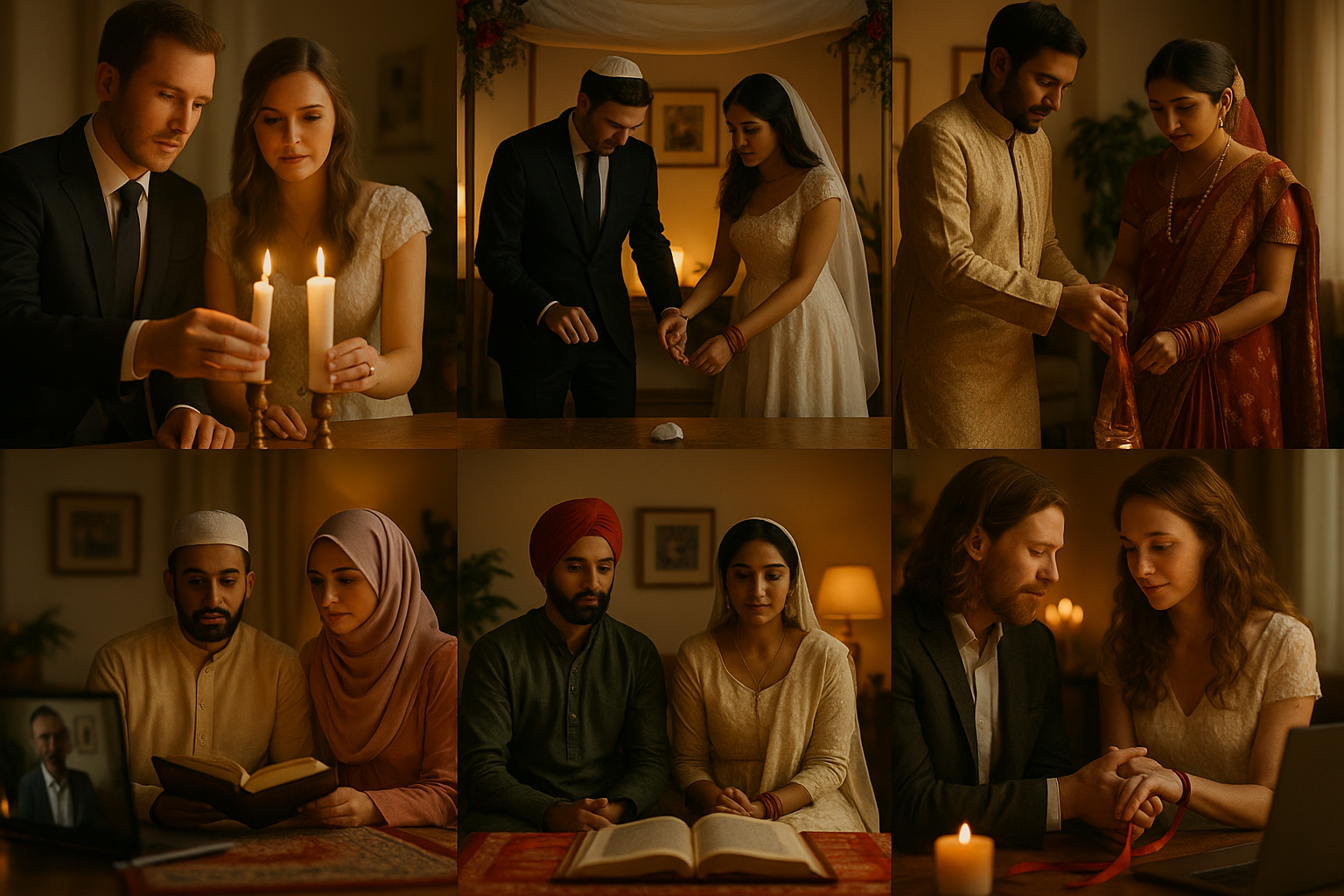Planning a virtual wedding and wondering how to incorporate your religious traditions? You’re not alone! Many couples are choosing to get married online and are finding creative ways to honor their faiths. Let’s explore how various religious wedding traditions can be adapted for virtual ceremonies.
Christian Virtual Weddings: Unity Candle Ceremony
The Unity Candle Ceremony is a cherished Christian tradition symbolizing the union of two individuals into one. In a virtual setting, each partner can light a candle in their respective locations and then simultaneously light a larger candle together, representing their new life as one. This beautiful ritual can be coordinated over a video call, allowing family and friends to witness the act in real-time. Learn more about incorporating this tradition into your virtual wedding on our Virtual Wedding Ceremony Styles You Can Copy page.
Jewish Virtual Weddings: The Chuppah and Breaking of the Glass
In Jewish weddings, the chuppah (wedding canopy) symbolizes the couple’s new home. For a virtual ceremony, couples can set up a chuppah in their own space, ensuring it’s visible to all attendees via video. The breaking of the glass, traditionally performed by the groom, can also be adapted. The groom can break the glass in his location, with guests shouting “Mazel Tov!” in unison from their respective locations. This adaptation maintains the essence of the tradition while embracing the virtual format. For more insights, check out our article on Virtual Weddings and Cultural Traditions: What to Expect.
Hindu Virtual Weddings: Saptapadi (Seven Steps)
The Saptapadi, or seven steps, is a pivotal Hindu wedding ritual where the couple takes seven steps together, each representing a vow. In a virtual ceremony, the couple can perform these steps in their respective locations, with the officiant guiding the process over video. This adaptation allows the couple to honor this significant tradition while accommodating the virtual format. Discover more about incorporating Hindu traditions into your virtual wedding on our Embracing Hindu Traditions in Virtual Marriage Ceremonies page.
Muslim Virtual Weddings: Nikah Ceremony
The Nikah is the Islamic marriage contract ceremony. In a virtual setting, the couple, officiant, and witnesses can join a secure video call to perform the Nikah. The officiant can recite the necessary prayers and guide the couple through the vows, ensuring all Islamic legal requirements are met. This approach allows couples to honor their faith while embracing the convenience of a virtual ceremony.
Sikh Virtual Weddings: Anand Karaj
The Anand Karaj is the Sikh marriage ceremony, traditionally held in a Gurdwara. For a virtual adaptation, the couple can set up a sacred space in their home, with the Guru Granth Sahib present. The officiant can join via video call to conduct the ceremony, guiding the couple through the Lavan (four hymns) and other rituals. This setup allows the couple to honor their faith while accommodating the virtual format.
Pagan Virtual Weddings: Handfasting Ceremony
Handfasting is a traditional Pagan ritual symbolizing the binding of two lives. In a virtual ceremony, the couple can perform the handfasting themselves, with the officiant guiding the process over video. They can use a cord or ribbon to bind their hands together, symbolizing their union. This adaptation maintains the ritual’s significance while embracing the virtual format. Learn more about incorporating handfasting into your virtual wedding on our Cross-Cultural Virtual Weddings: Unique Rituals to Enrich Your Online Ceremony page.
FAQs
Can we incorporate multiple religious traditions into our virtual wedding?
Absolutely! Virtual weddings offer the flexibility to blend various religious traditions, creating a ceremony that reflects both partners’ faiths. Coordination and clear communication with your officiant and participants are key to seamlessly integrating multiple rituals.
How can we ensure our virtual wedding is legally recognized?
To ensure your virtual wedding is legally recognized, it’s essential to work with a reputable service that specializes in online marriages. At Virtual Same Day Marriage, we guide you through the legal requirements and provide support to make your virtual wedding both meaningful and legally binding. Learn more about our services on our How It Works page.
Can family and friends participate in our virtual wedding?
Yes, family and friends can actively participate in your virtual wedding. They can join the ceremony via video call, offer blessings, read scriptures, or even perform musical pieces. Engaging your loved ones adds a personal touch and makes the virtual experience more intimate.
What technical considerations should we keep in mind for a virtual wedding?
Ensure a stable internet connection, use a reliable video conferencing platform, and test all equipment beforehand. It’s also helpful to have a tech-savvy person on hand to manage any issues that may arise during the ceremony.
How can we make our virtual wedding feel special and unique?
Personalize your virtual wedding by incorporating meaningful rituals, decorating your space, dressing in traditional attire, and involving loved ones. Adding elements like music, readings, and cultural symbols can also enhance the experience.
Embracing virtual weddings doesn’t mean sacrificing the rich traditions that make your ceremony special. With thoughtful planning and creativity, you can honor your religious customs and create a memorable and meaningful virtual wedding. At Virtual Same Day Marriage, we’re here to help you navigate the planning process and ensure your virtual wedding is as special and unique as your love story. Ready to start planning? Contact us today to make your dream virtual wedding a reality.




